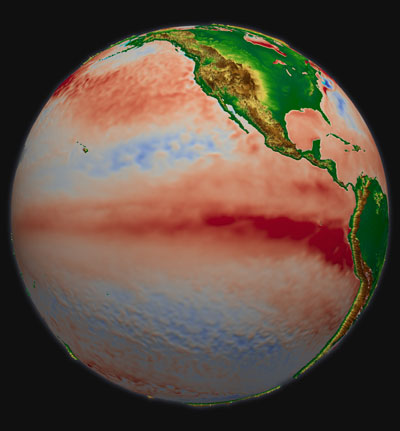“A Major Conceptual Advance” on El Niño
World’s best-known climate phenomenon acted very differently in 2023
Published Date
Article Content
El Niño years in the western United States are usually soggy, warm affairs while countries on the other side of the Pacific Ocean like Indonesia suffer from drought. The east-west shift of a warm blob of water in the equatorial Pacific Ocean has been the main characteristic of El Niño, but 2023 flipped the script, says a team of researchers led by Scripps Institution of Oceanography at UC San Diego.
Qihua Peng, a postdoctoral researcher at Scripps Oceanography, Scripps climate scientist Shang-Ping Xie and colleagues simulated the 2023 event and found that it was very pronounced even though a crucial element — dying trade winds in the Pacific — wasn’t there.
“Using global climate models, we show that unusually warm water in the tropical Atlantic and Indian oceans kept the Pacific trade wind strong even as the El Niño was growing,” said Peng.
Before, scientists had considered El Niño a product wholly produced in the Pacific Ocean that goes on to influence global weather.

Xie described the study as a “major conceptual advance” in the understanding of the phenomenon. The study suggests that forecasters need to look beyond the tropical Pacific in predicting El Niño. The authors added that more work is needed to put the 2023 event in context: Was it a one-off or perhaps an indication of things to come as ocean basins continue to warm?
The study was published today in Nature Geoscience. Co-authors include Clara Deser of the National Center for Atmospheric Research and Ayumu Miyamoto, Pengcheng Zhang and Matthew Luongo of Scripps Oceanography. Support for the study came from the National Science Foundation (AGS 2105654), the Japanese Ministry of Education, Culture, Sports, Science and Technology programmes for the advanced studies of climate change projection (JPMXD0722680395), NASA (80NSSC24M0010; FINESST Graduate Fellowship 80NSSC22K1528), the Cooperative Institute for Climate, Ocean and Ecosystem Studies (CICOES) under a NOAA Cooperative Agreement NA20OAR4320271 and the National Center for Atmospheric Research.
Read the study in Nature Geoscience: https://www.nature.com/articles/s41561-025-01700-9
Share This:
You May Also Like
Stay in the Know
Keep up with all the latest from UC San Diego. Subscribe to the newsletter today.




